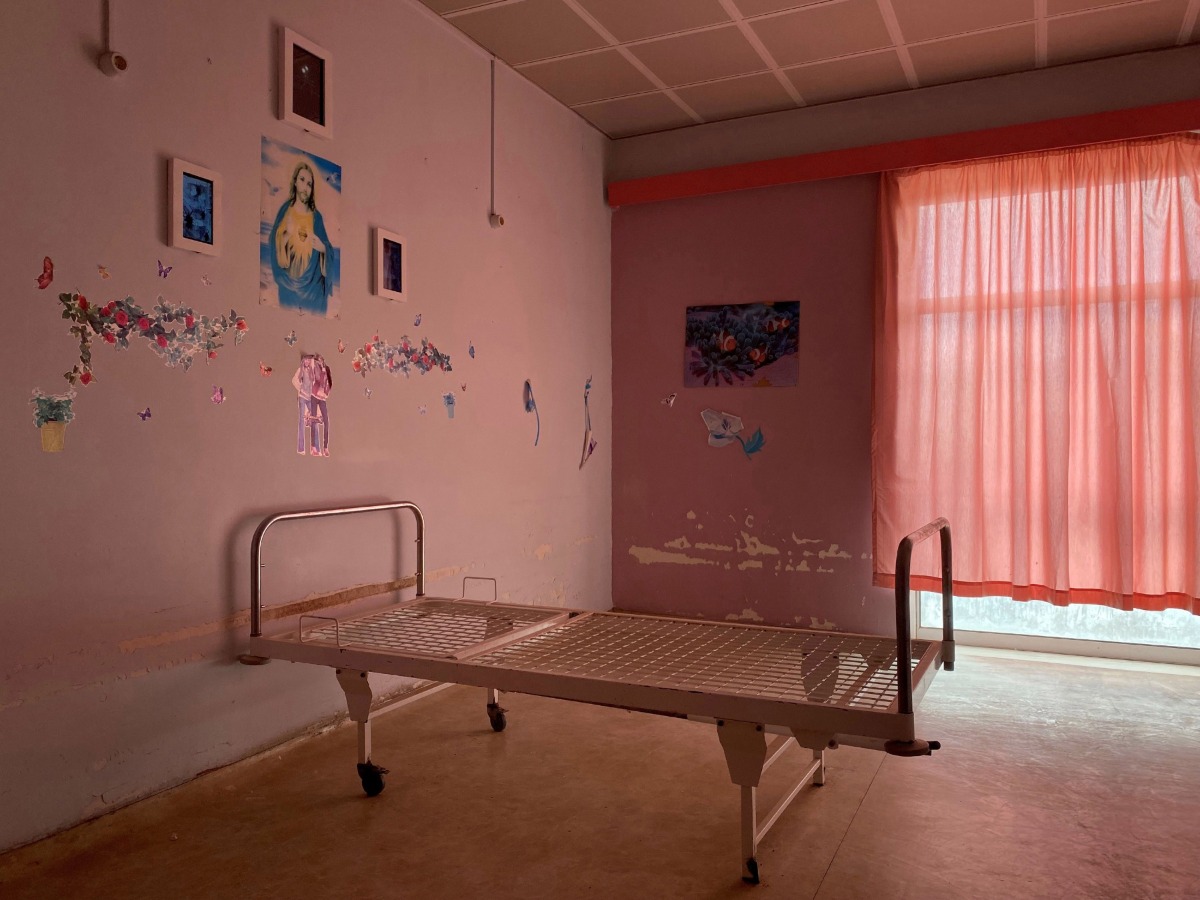
Turning Inwards
An exhibition at Dafni Psychiatric Hospital in Athens
Is there a sacred self, a place within us where we find ourselves rooted? This seems to be the assumption underlying the exhibition Reality Check Chapter II: Inner Sanctum, in Athens. The group show takes place in an abandoned building at the (still operative) Psychiatric Hospital of Attica, called “Dafni” for short. “Going to Dafni,” for inhabitants of Athens, usually means that you have lost it or need treatment, or it is meant as a joke. But going to Dafni to visit this exhibition is rather a pleasure, a proposition to have a checkup, see where you are in life, what you believe, where you are heading. The reason you might find some answers is that 36 contemporary artists have presented their vision of what could be an inner sanctum. They offer options, projections, and inspiration. Each of them has a room which they have transformed, often into an immersive experience, be it through video, scent, sound, ceramics, or words written on the wall.
Lydia Dambassina - A Word Observes You (2022) installation view. Photo by Manolis Baboussis. © the artist and courtesy of Artefact Athens
“We sail towards an unknown direction,” curator Kostas Prapoglou writes in the introduction to the exhibition. “The ‘unknown’ often disarms, disorients and paralyzes us. And yet, an inner driving force awakens us, challenges us to continue, to breathe, to feel, to love…” The exhibition can be taken as an invitation to reflect on anticipated futures, on what direction to take, on what to believe in, and it clearly takes its nourishment from today’s world, including its conflicts, fears and neuroses. We have reasons enough to lose track and get disconnected from the inner sanctum.
Nikos Tranos - Primavera (2022), installation view. © the artist and courtesy of Artefact Athens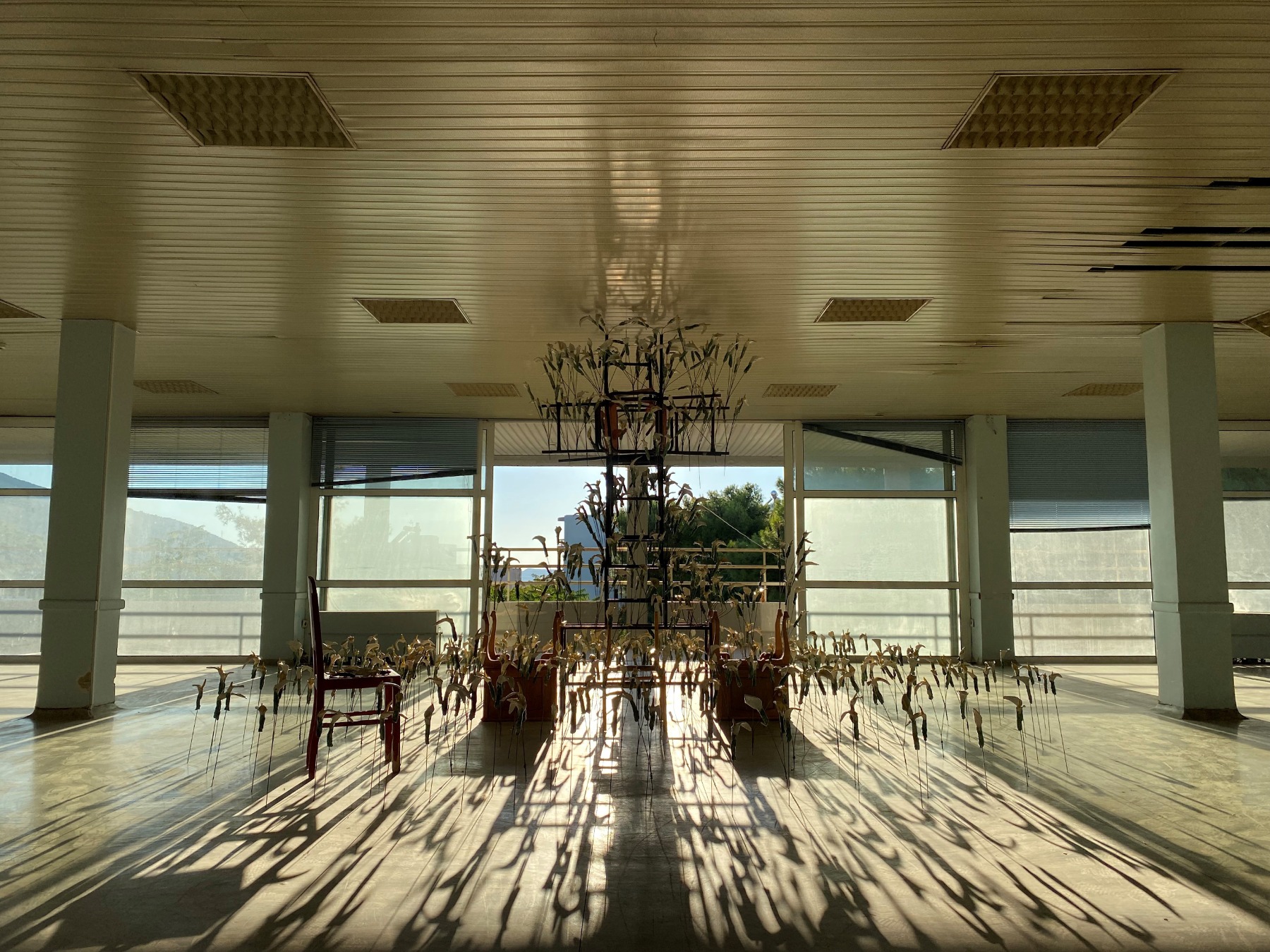
In the center of the building, where the visitors enter, an installation of glazed ceramic lilies, Primavera (2022) by Nikos Tranos, suggests a place of freshness and seasonal rebirth. The flowers are pinned into the ground or “grow” from pieces of furniture piled up in the rundown space. Behind the sea of flowers, one can go outside on the balcony to look over the surrounding hills, an area where the metropolitan area of Athens comes to an end. For people hospitalized here, it might feel like the end of the world, even though moments of beauty present itself, such as when the sun goes down, mixing an orange with blue.
Dimitris Skourogiannis - Birthday (2022), installation view. © the artist and courtesy of Artefact Athens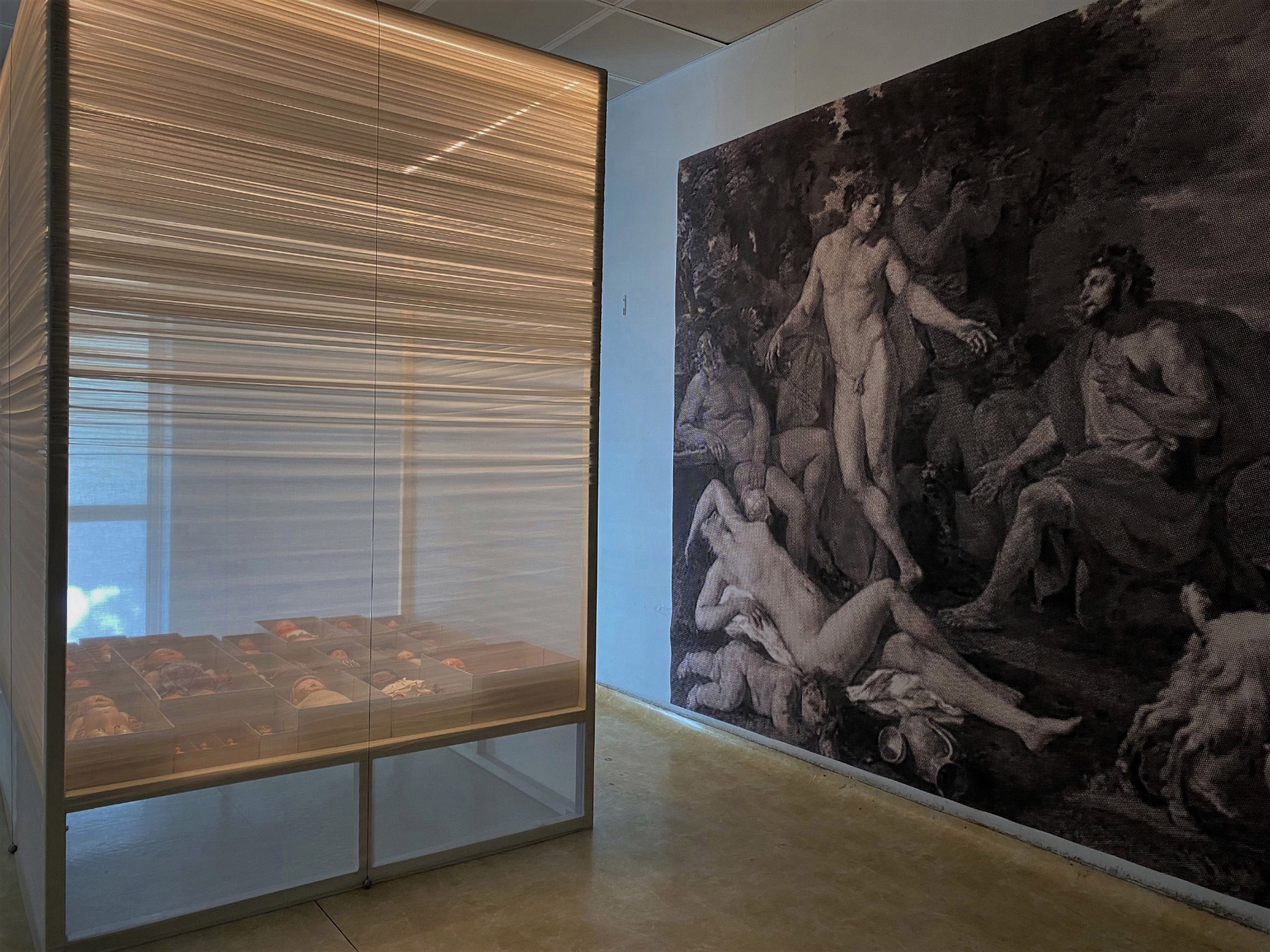
In terms of light and dark, the exhibition has a large span, and not just in a literal way. In the right wing of the building, darkness seems to prevail. The artists at work here found their inner sanctum under pressure. Or their work seems to witness the battle it took to get there, to reach for a sacred space, create a shelter that keeps pressure outside. A drawing by the late Yannoulis Chalepas hints at a frustrated, if not disturbed, artist's life. The now famous Greek sculptor spent years in a psychiatric hospital on Corfu, and much of his work was destroyed either by himself or by his mother who thought art to be a demon rather than an extraordinary talent her son possessed. Only after she passed away could he fully unfold his inner and artistic vision. The display of his drawing Saint George and the Dragon (c. 1930), only visible through the small strip of an observation window, reminds viewers of Chalepas’ own biography, his struggle, but also brings to mind the many patients that lived under questionable circumstances in asylums, behind closed doors.
Tori Wranes - Echo Face. © the artist and courtesy of Artefact Athens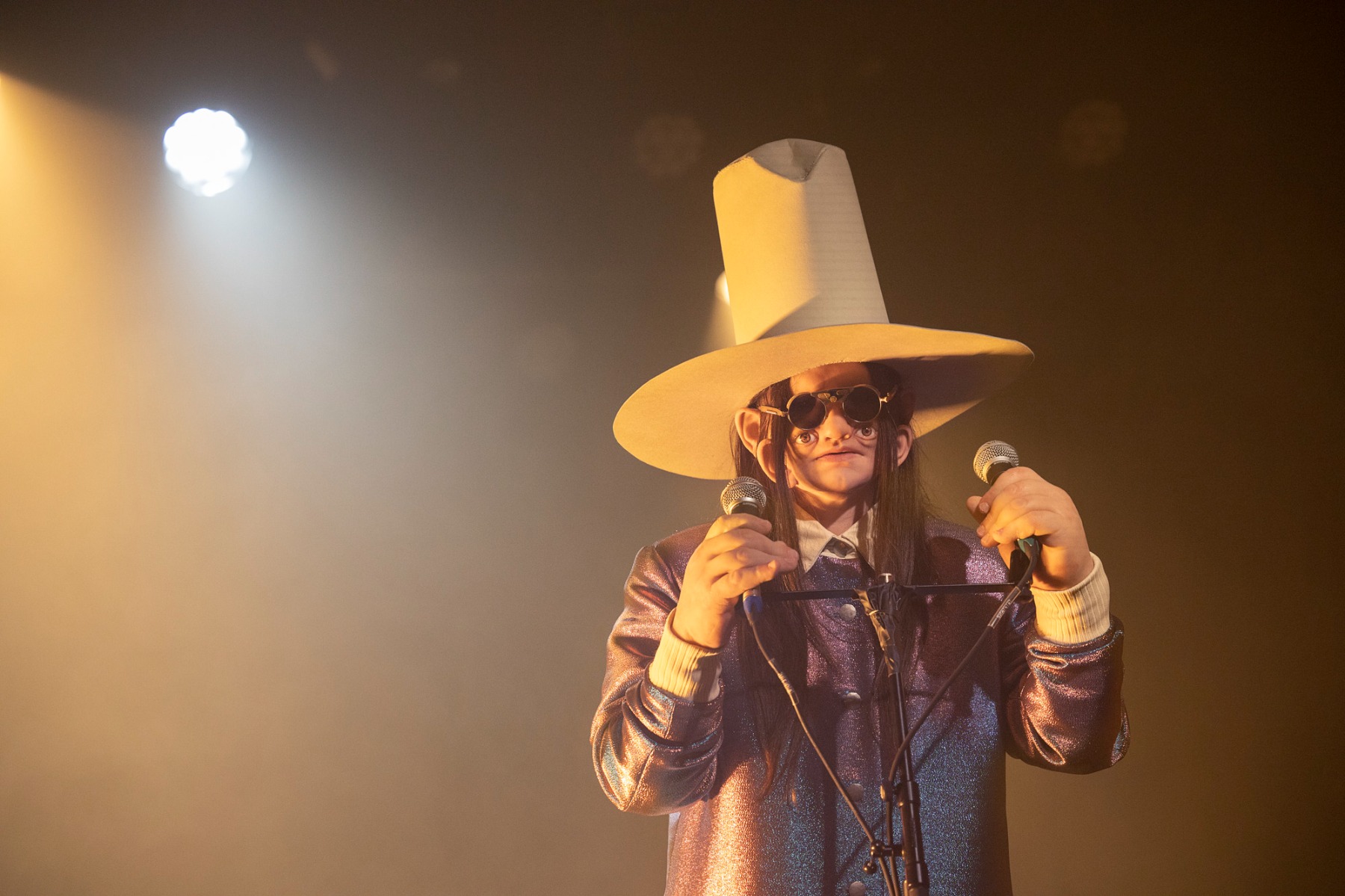
A video work by Norwegian artist Tori Wrånes, ECHO FACE (2020-22), is both captivating and strange. A figure with an extra pair of eyes and ears is doing a performance. The artist appears wearing sunglasses and a high hat, having a double self, and she also has two microphones in front of her to accommodate her echo. The piece is dark and intense, but the singing is also intoxicating and powerful in its presence. It draws you in. We witness a person who does not ask but takes the space to express what dwells inside her. And as a visitor, one feels some sense of liberation. To be free, one needs examples to look at.
“This power is the inner sanctum that dwells and hides in our souls,” Prapoglou continues in his introduction, referring to the key concept with which he challenged the participating artists. “It is the place that makes us feel at home. It is our refuge, the locus of our inner flame, our precious sanctuary. It may take time for each of us to discover and realize it. It is usually revealed as the prize for numerous intangible battles, as a trophy of a great victory. It is reminiscent of the inner initiation process of those who were heading to Eleusis during the Sacred Mysteries.” This last sentence alludes to the fact that Dafni is located on the road between Athens and Elefsina, where in antiquity the so-called sacred mysteries took place.
Evi Savvaidi - Wonderland (2022), installation view. © the artist and courtesy of Artefact Athens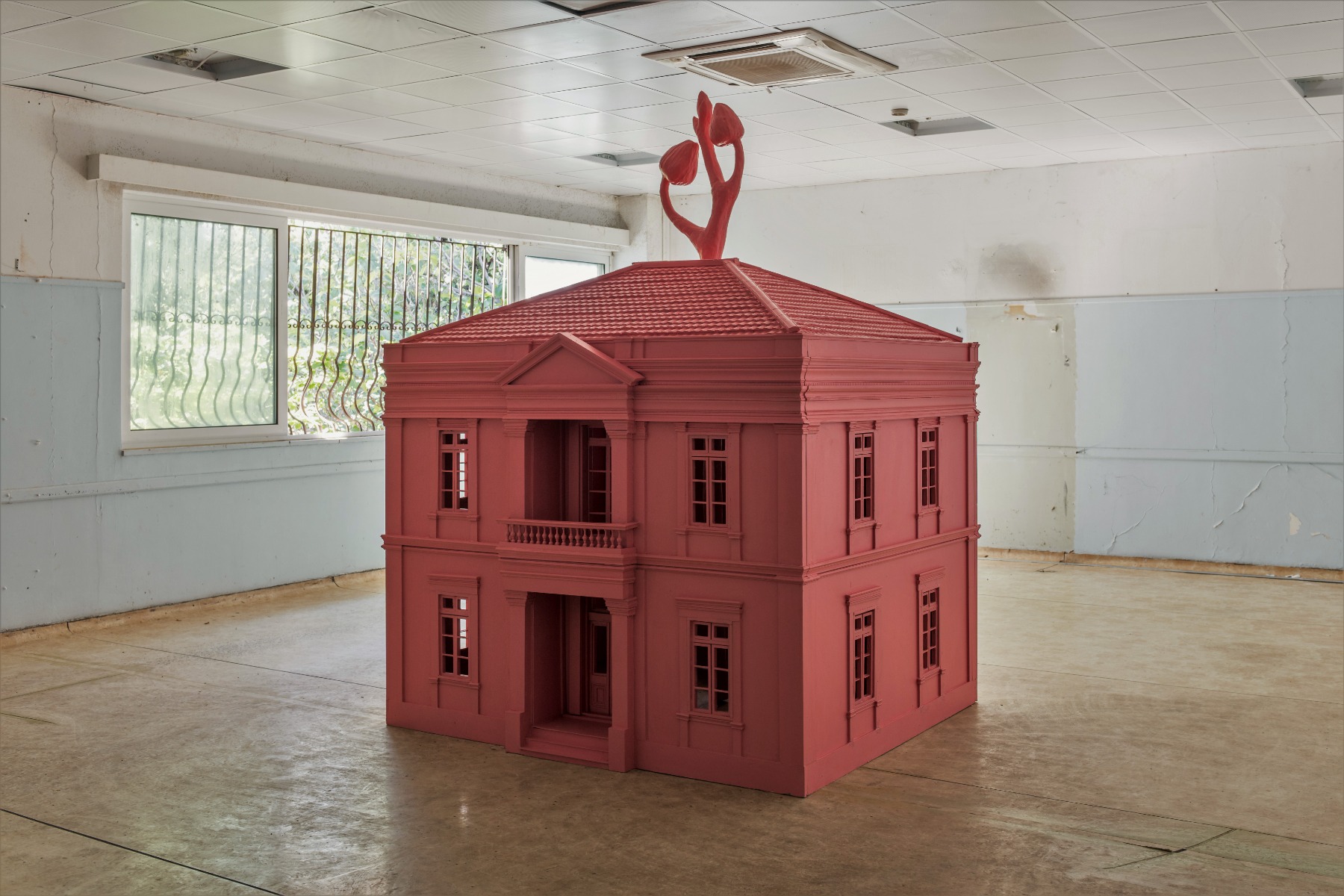
A monumental calmness comes from the sculpture Wonderland (2022) by Evi Savvaidi. She has built a scale model of a neoclassical house, all cast in pink, and from the roof a graceful flower appears. In the center of an empty room, the house projects the possibility of a home, of a safe space within the less hospitable context of the hospital. As an image it is easy to relate to, even if it is not clear whether it should be seen as a memory, a projection, or a fantasy. The sanctum here is a place we call home.
Nadia Skordopoulou - Your soul that never wears, Your spirit that never tears (2022) installation view. © the artist and courtesy of Artefact Athens
In the left wing of the building, some pieces can be discovered that are lighter in tone, color and atmosphere, even though this usually comes with a twist. There is an installation by Nadia Skordopoulou with real flowers hanging from the ceiling, their roots not connected to the ground (like humans, one could say), even though there is some soil on the floor. The flowers seem to be kept alive through steam that comes from machines on the ground. Your soul that never wears, your spirit that never tears (2022) is the name she gave the image that shows displacement and invisible rooting at the same time.
Dimitra Skandali - ..any courage is a fear.. (2022), installation view. © the artist and courtesy of Artefact Athens
Dimitra Skandali brought not only plants, dried flowers, and herbs from the island of Paros to build curtain-like shapes – she also brought the smell that these plants carry, together forming the installation Any courage is a fear, a title taken from a poem by E.E. Cummings. Entering the room lit by abstract video projections, one is easily transported to an inner landscape, a nature once experienced maybe through smell, or in a dream. Landscape, in Skandali’s art, has stopped being figurative decor or a specific geographical place. Made with real natural material, her work offers an abstract setting, or, you could say, an inner landscape, including a pool for self-reflection.
Venue interior. © courtesy of Artefact Athens
Reality Check Chapter II: Inner Sanctum delves into the innermost visions of artists. To get there, the artists present situations that have confronted them with limits, with their fears and hopes. It involved the challenge of an individual to synchronize with the outside reality, just like the patients in the adjacent pavilions must cope with. But the artists do this within the freedom to stage dilemmas and experiences, blessed and guided by the artistic form they have found and developed.
With its diverse range of aesthetics, temperaments, and beliefs, it is striking how well the works come together. One does not have to like all the works to appreciate the lineup. The exhibition is coherent – not through style, a specific medium, or message, but through a shared focus. It seems that the artists were well aware that they had only one chance to hit the essence of their practice, one room in the exhibition, and they took it passionately. Thus, a quality comes out that one often misses in biennials or thematically curated shows. The curator inspired or possibly even provoked the artists by presenting his quest, and from there an organic trajectory developed. Within the diversity one thing is clear: to reach the inner sanctum, and to be able to create from that place, it takes courage, as you might have to face some monsters along the way.
Poster of the exhibition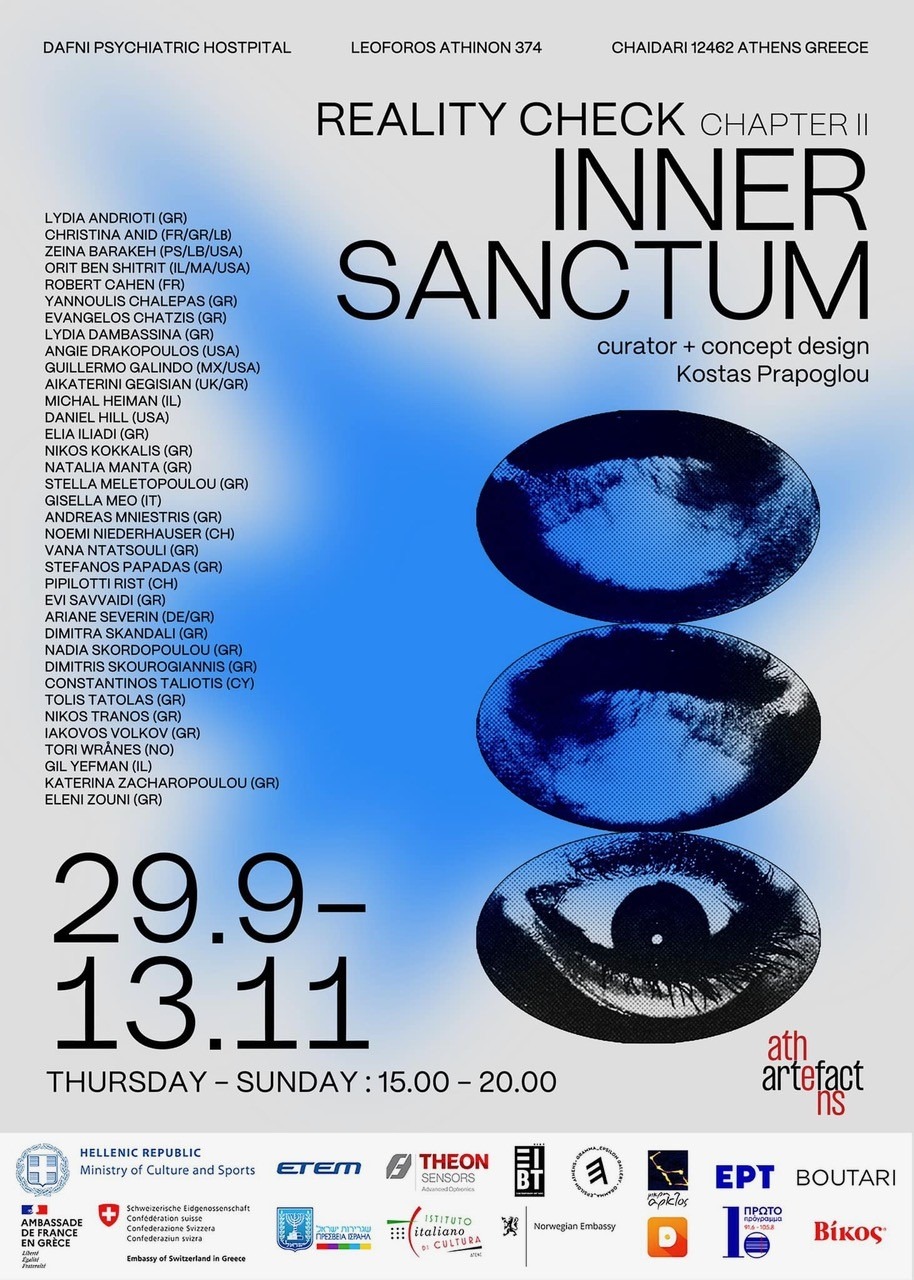
Title image: Giuillermo Galindo - You faked your way into my dreams, now let me die in peace (2022) installation view. © the artist and courtesy of Artefact Athens